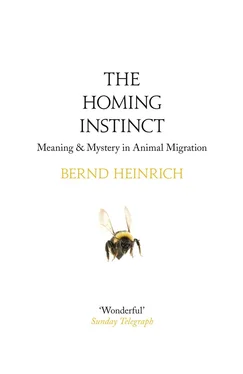Since hibernation concerns adaptations related to temperature, Otter concentrated his efforts on unraveling the beetles’ temperature tolerance and compared it to the temperature at that site. But, curiously, there was nothing unique about the temperature of the specific site on “Ladybug Hill,” relative to other sites near it. Nor did the grouping of the beetles affect their temperature; the temperature of their aggregation was indistinguishable from ambient temperature. So, they didn’t aggregate to keep warmer than the environment there.
As already mentioned, the one thing all ladybug beetles do have in common is that they stink. The evolutionary significance of their aggregations is therefore likely the conventional one of other animals, namely, to advertise their noxiousness for protection from predators. Shrews and other predators may kill two or three victims and then spit them out, but they then learn to avoid them and so they do not continue eating the hundreds of thousands they would consume if they had found a bonanza of ladybirds. Given their safety of numbers, it is advantageous for any one beetle to join a group rather than to overwinter alone, because the chances that it will become a victim of a shrew’s educational process are reduced in more or less direct proportion to the group number. This rationale for large numbers of beetles, but of different individuals, massing repeatedly at the same location is not proven, but my colleague Daniel F. Vogt and I found that it applied to another noxious-smelling beetle, the whirligig (Gyrinidae) water beetles in Lake Itasca in Minnesota. These beetles there homed in on any existing groups of tens of thousands at dawn, after a night of foraging far and wide on the surface of the lake.
The second question is: How is an aggregation formed?
Insects have an impressive ability to home in on scent, and ladybird beetles could find the aggregation by following an odor plume. Memory cannot be involved in the ladybugs that Otter found year after year aggregating at the same site, which were generations removed from those of the previous year. The beetles arrive on site in September, stay there eight months, and in May return to the valley floor to feed, mate, and reproduce. Only their descendants, two or three generations later, could return to the tiny spot where they had hibernated.
The aphids’ rule of flying up toward the light, to then be dispersed by the wind, and then homing in on green when they settle could be a model of what happens in ladybird aggregation. Ladybirds are much stronger fliers than aphids, although they too are swept along in updrafts. But such drifting, while helping to account for their annual ascent from the lowlands into the mountains, does nothing to explain how tens of thousands of them end up under the same rock pile.
If the ladybirds home in on color, this could be tested, as the aphids’ homing in on food plants was tested — by leaving color targets at sites other than the traditional hibernaculum. But even if red color is an attractant (highly unlikely because the beetles aggregate under the rocks, not on them), that still would not explain their annual return to the same place in successive years. Do they smell their ancestors? Could thousands of smelly beetles piled up for eight months leave sufficient scent residue to serve as a marker that allows others to home in on the spot? If so, this idea could also be tested, by transferring an aggregation of beetles to overwinter at another physically similar place in the same general area as the old to see if a new traditional homing site for their mutual protection is created.
BY THE SUN, STARS, AND MAGNETIC COMPASS
Life has unfathomable secrets. Human knowledge will be erased from the world’s archives before we possess the last word that a gnat has to say to us.
— Jean-Henri Fabre
CHARLES DARWIN REFERRED TO THE ACCOUNT OF FERDINAND von Wrangel’s Arctic explorations, The Expedition to North Siberia, concerning how we home, quoting von Wrangel on how the Siberians oriented by “a sort of ‘dead reckoning’ which is chiefly affected by eyesight, but partly, perhaps, by the sense of muscular movement, in the same manner that a man with his eyes closed can proceed (and some men much better than others) for a short distance in a nearly straight line, or turn at right angles and back again.” Darwin compared a bird’s homing capability with that of people, but much less favorably, by telling how John James Audubon kept a wild pinioned goose in confinement, which at migration time became “extremely restless, like all other migratory birds under such circumstances; and at last it escaped. The poor creature immediately began its long journey on foot, but its sense of direction seemed to have been perverted, for instead of traveling due southward, it proceeded in exactly the wrong direction, due northward.” I’m not the least surprised at the behavior of the goose but all the more puzzled by our own orienting, which involves knowledge versus a feeling of “sense of direction.” I recall instances of waking up in “total” dark, “knowing” in my mind precisely how I am oriented relative to the room and hence the rest of my environment, but irked by “feeling” that I am in the precise opposite direction. It is then a struggle to get the two to agree, which happens only after some effort.
In Darwin’s time it was still supposed that humans had overall superiority over other animals. His then-hypothesis (later theory, and now fact) of evolution, which now binds us all as kin, was still revolutionary. Darwin found the goose’s behavior puzzling because he could not know that geese, cranes, and swans stay together in family and larger groups and that although the young by themselves do not know the correct migration route, they learn to know it from their parents which in turn learned it from theirs. Other birds have their migratory directions genetically coded, and they go strictly by “feeling,” since many of these have no knowledge because they migrate ahead of their parents.
We humans get lost easily. We would not get far without reference to landmarks, and I base that conjecture on (inadvertent) experiments. In one I was in long-familiar woods and got caught in a heavy snowstorm. Suddenly I got “turned around,” and it seemed as if all landmarks had in almost one instant been erased. But I kept going, trying to maintain a straight line by trusting my “sense of direction.” When I thought I had reached a place that I knew, where I should be going downhill, the landscape was instead sloping upward, and the brook I had expected to see was going in the “wrong” direction. At that point, knowing I was lost and no longer referencing to any signal, I backtracked in the snow and discovered that I had been walking in a circle, all the while thinking I was heading in the “right” direction. Yes, we can walk, a short way, in a relatively straight line with our eyes closed, by a process dubbed “path integration,” but my emphasis here is on “relatively.” Mice may do better. A friend told me of catching a Mexican jumping mouse in a live trap baited with peanuts. It had a kink in its tail, so he called it Crooked Tail, or CT for short. After he had released it several times, and it always returned for another snack of peanuts at the same source, he finally decided to “test its mettle” and released it exactly one kilometer away in thick brush and grass. The next morning CT was back for another snack. After release from two kilometers, though, it did not return. We don’t know, though, if this was due to failed navigation, finding a new food, a cost/benefit calculation, or a run-in with a coyote, owl, or weasel. On the other hand, when I failed to navigate, I was positive that I had been going in the precise opposite direction, which meant I had no sense of direction whatsoever, except that coming from visual landmarks from which I had constructed a map in my head.
Читать дальше












